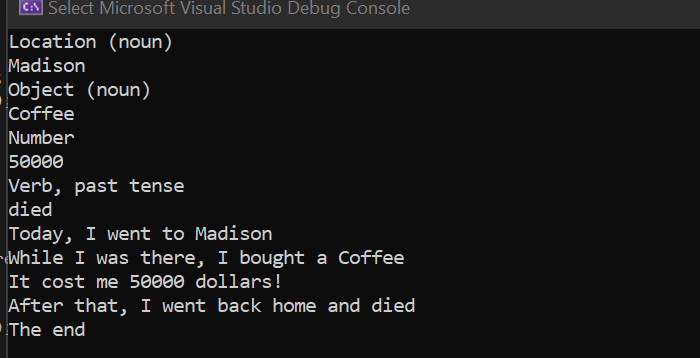Let’s Make A Madlib!
Have you heard of a Madlib? It’s a sort of game that was invented in 1953 by Leonard Sterrn and Roger Price. The basic idea is that the player is prompted for a series of words and phrases, without knowing how those will fit into a story. Then the player reads back the story, inserting their chosen words and phrases at key points, to hilarious results.
The original madlibs were presented in book form - we’re going to write a computer program madlib!
This program will be a little longer, and you’re going to have to design the story structure, so get ready to get creative!
Make a new Console Application
Before we start, it’s a good idea at this point to make a brand new C# console application. Just follow the directions from the first lesson, and call your new project “Madlib”.
Overview
Here’s the basic structure of our program:
- We’ll ask the user for a word or phrase one at a time, and store their answer in a series of variables, each with its own unique name.
- Then we’ll print out the story at the end, using all of those stored variables to generate a story.
using System;
Console.WriteLine("Location (noun)");
string Location1 = Console.ReadLine();
Console.WriteLine("Object (noun)");
string Object1 = Console.ReadLine();
Console.WriteLine("Number");
//note: We could have used an int here, but it doesn't actually matter if it's a string.
string number = Console.ReadLine();
Console.WriteLine("Verb, past tense");
string verb1 = Console.ReadLine();
//Now output our story.
Console.WriteLine("Today, I went to " +Location1);
Console.WriteLine("While I was there, I bought a " + Object1);
Console.WriteLine("It cost me " + number+" dollars!");
Console.WriteLine("After that, I went back home and " + verb1);
Console.WriteLine("The end");If you run the program, it will look something like this:

Coding Time!
Alright - up until now, we’ve walked you through every step with these lessons. Now, it’s time for you to get creative and expand this ‘madlib’ program to make it your own.
- Replace the example story structure with your own.
- Add 10-15 more words and phrases
You may want to test run your program frequently, in case you accidentally add any errors.